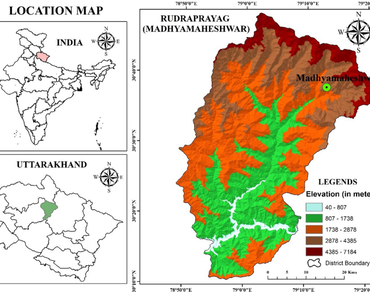Documentation of ethnobotany: a source for conservation plan of Medicinal plant species in alpine region of Madhmaheshwar, Uttarakhand, India
Research Articles | Published: 10 October, 2022
First Page: 989
Last Page: 998
Views: 3091
Keywords: Madhmaheshwar valley, Alpine area, Ethnobotany, Traditional, Himalayan plants
Abstract
Madhmaheshwar is a floristically diverse valley in Uttrakhand, India where local people particularly tribals are dependent on wild plants and have a vast ethnobotanical knowledge. The ethnobotanical knowledge among the tribals and local people gets transmitted through oral dialogue, therefore needs to be documented. During the study, questionnaire has been used to document the ethnobotanical information and statistically analyzed using ethnobotanical indices. The present work documented 59 plant species which were distributed in 50 genera under 29 families from 43 informants. Maximum number of species are used to cure gastro-intestinal and dermatological disorders. Paste and decoction are the most popular recipes among the documented species and Asteraceae (13.55%) and Ranunculaceae (8.47%) are the dominant families in ethnobotanical usage. Picrorhiza kurroa, Arnebia benthamii, Rheum webbianum and Podophyllum hexandrum with high Use Value are the most dominant species to be used by the inhabitants of the study area. High degree of factor informant consensus values indicates significant homogeneity and transmittance of knowledge among the people of study area.

References
Aswal BS, Mehrotra BN (1994) Flora of Lahaul-Spiti (A Cold Desert in North West Himalaya). Bishen Singh Mahendra Pal Singh, Dehradun
Bhatia H, Sharma YP, Manhas RK, Kumar K (2014) Ethnomedicinal plants used by the people of district Udhampur, J&K, India. J Ethnopharmacol 151:1005–1018
Bouafia M, Amamou F, Gherib M, Benaissa M, Azzi R, Nemmiche S (2021) Ethnobotanical and ethnomedicinal analysis of wild medicinal plants traditionally used in Naâma, southwest Algeria. Vegetos 34:654–662. https://doi.org/10.1007/s42535-021-00229-7
Das AP (2021) Herbarium technique. In: Bhandari JB, Gurung C (eds) Instruments manual in biology. Narosa Publishing House, New Delhi, pp 78–94
Dutt HC, Bhagat N, Pandita S (2015) Oral traditional knowledge on medicinal plants in jeopardy among Gaddi shepherds in hills of northwestern Himalaya, J&K, India. J Ethnopharmacol 168:337–348
Gaur RD (1999) Flora of the District Garhwal: North West Himalaya (with Ethnobotanical Notes). University of Chicago, TransMedia
India state of forest report (2017) Uttarakhand. Forest and tree resources in states and union territories, pp 308–313
Jain SK, Rao RR (1977) A handbook of field and herbarium methods. Today and Tomorrow Printers and Publishers, New Delhi
Jyotsana S, Gaur RD, Painuli RM (2011) Conservation status and diversity of some important plants in the Shiwalik Himalaya of Uttarakhand, India. Int J Med Aromat Plants 1(2):75–82
Kachroo P, Sapru BL, Dhar U (1977) Flora of Ladakh. Bishen Singh Mahendra Pal Singh, Dehradun, p 172
Kala CP, Dhyani PP, Sajwan BS (2006) Developing the medicinal plants sector in northern India: challenges and opportunities. J Ethnobiol Ethnomed. https://doi.org/10.1186/1746-4269-2-32
Khatri OS, Chaudhary S, Shrestha N, Munankarmi NN (2021) Ethnomedicinal study and phytochemical screening of selected plants in Jhule, Dolakha District, Nepal. Vegetos 34:834–846. https://doi.org/10.1007/s42535-021-00266-2
Kumar K, Sharma YP, Manhas RK, Bhatia H (2015) Ethnomedicinal plants of Shankaracharya Hill, Srinagar, J&K, India. J Ethnopharmacol 170:255–274
Negi CS (2014) The sacred Uttarakhand: ethno-biological study surrounding sacred natural sites in Uttarakhand. Bishen Singh Mahendra Pal Singh, Dehradun, India
Njoroge GN, Kaibui IM, Njenga PK, Odhiambo PO (2010) Utilization of priority traditional medicinal plants and local people’s knowledge on their conservation status in arid lands of Kenya (Mwingi District). J Ethnobiol Ethnomed 6:22
Pande PC, Tiwari L, Pande HC (2006) Folk-medicine and aromatic plants of Uttaranchal. Bishen Singh Mahendra Pal Singh, Dehradun
Polunin O, Stainton A (1984) Flowers of himalaya. Oxford University Press, New Delhi, p 580
Pushpangadan P, Kumar B (2005) Ethnobotany, CBD, WTO and the Biodiversity Act of India. Ethnobotany 17:2–12
Samant SS, Dhar U, Palni LMS (1998) Medicinal plants of Indian Himalaya. Gyanodaya Prakashan
Shah NC (2018) Plants of Kedarnath Wildlife Sanctuary, Western Himalaya: a field guide by Ishwari Datt Rai, Gajendra Singh & Gopal Singh Rawat. Bishen Singh Mahendra Pal Singh, Dehradun
Singh G, Rawat GS (2011) Ethnomedicinal survey of Kedarnath wildlife sanctuary in Western Himalaya, India. Indian J Fundam Appl Life Sci 1(1):35–46
Singh D, Srivastava R, Khanduri VP (2005) Marketing strategies and trade of medicinal plants in Uttaranchal: present and future prospects. Indian for 131(3):330–340
Srivastava N (2015) Medicobotany of Garhwal Himalaya. Deep Publishers, New Delhi
Tashi N, Thakur S, Sudan J, Dutt HC (2019) Impact of modern medicine on traditional knowledge among remote populace in Jammu Shivaliks, North-Western Himalaya. Researcher 15(2):1–16
Thakur S, Dutt HC (2020) Homogeneity in traditional knowledge and cultural importance of wild edible plants in Kishtwar—a Himalayan district in North-West Himalaya. Pleione 14(2):277–291
Thakur S, Tashi N, Singh B, Dutt HC, Singh B (2020) Ethnobotanical plants used for gastrointestinal ailments by the inhabitants of Kishtwar plateau in Northwestern Himalaya, India. Indian J Tradition Knowl 19(2):288–298
Author Information
Department of Botany and Microbiology, HNB Garhwal University, Srinagar (Garhwal), India